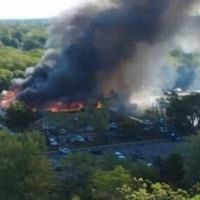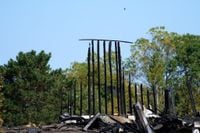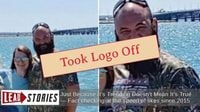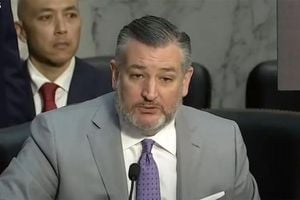On Sunday morning, September 28, 2025, the tranquility of a small Michigan church service was shattered in a matter of moments. Just before 10:30 a.m., Thomas Jacob Sanford, a 40-year-old resident of Burton, Michigan, drove his vehicle through the front doors of the Church of Jesus Christ of Latter-day Saints in Grand Blanc Township. What followed was a scene of chaos, terror, and heartbreak that left the congregation and the wider community reeling.
According to reports from CBS News and Newsweek, Sanford exited his vehicle armed with an assault rifle and began firing at the approximately 100 worshippers inside. The sudden eruption of violence stunned those present. Paul Kirby, a church member who survived the attack, recounted the horror on “CBS Mornings”: “That was the scariest moment of my life, not knowing if my family was OK.” Kirby described hearing a “loud boom” and, like several other men, initially thought someone had crashed into the building by accident. But as he stepped outside to investigate, he saw Sanford holding a gun and opening fire. “Once I saw the gun and start hearing him start shooting it, it was just a lot of fear,” Kirby said. He recalled feeling shrapnel strike his leg and a bullet piercing a glass door just a foot away as he desperately tried to find his wife and children.
Sanford’s rampage did not end with gunfire. Authorities say he used an accelerant to ignite a blaze that quickly consumed much of the church building, compounding the devastation. The attack left at least four people dead and at least eight others wounded, including children. One of the injured was in critical condition, while seven others were reported in stable condition, according to CBS News Detroit. As of late Sunday, some congregants were still unaccounted for, police said, as investigators sifted through the charred remains for answers.
Responding officers arrived at the scene within minutes. In the exchange of gunfire that followed, Sanford was shot and killed, bringing the immediate threat to an end but leaving the community grappling with the aftermath. The FBI quickly took charge of the investigation, calling the incident “an act of targeted violence” and urging anyone with information to come forward.
Sanford was not an unknown figure in his community. As PolitiFact and The New York Times reported, he was a former U.S. Marine who served for more than three years, including a deployment to Iraq from August 2007 to March 2008. Friends and acquaintances described him as a man who had returned from military service more serious and, in recent years, increasingly troubled. Peter Tersigni, a close friend of Sanford’s family, told CNN that Sanford had developed a deep resentment toward the Mormon faith following a breakup with a girlfriend more than a decade ago. “He had the need to express and let us know, 'Hey, Mormons are bad, Mormons are the antichrist,'” Tersigni said. The relationship, which unfolded while Sanford was living in Utah, coincided with a period of heavy drug abuse, Tersigni added. When the relationship ended, Sanford returned to Michigan, where his animosity toward the Church of Jesus Christ of Latter-day Saints reportedly intensified.
In the weeks leading up to the attack, Sanford’s behavior became increasingly erratic. Residents told CNN that he had nearly run over a friend with his truck and openly declared his hatred for the LDS church. Burton City Council candidate Kris Johns told the Detroit Free Press that Sanford expressed negative views about the Mormon faith during a conversation just a week before the tragedy. White House Press Secretary Karoline Leavitt told Fox News that Sanford "hated people of the Mormon faith." Despite these accounts, law enforcement officials have released no definitive details about his motive, and the investigation remains ongoing.
In the immediate aftermath, the nation’s political climate became entwined with the tragedy. Photos surfaced showing Sanford wearing a “Trump 2020” shirt in a family photo posted in 2019, and a Trump campaign sign was visible outside his home in a June 2025 Google Maps image, according to PolitiFact and The Guardian. This led to a flurry of online speculation about Sanford’s political leanings, with some social media users labeling him a “MAGA supporter” and others claiming, without evidence, that he was a left-wing activist. However, Michigan does not register voters by party affiliation, and there is no public record of Sanford’s political registration. Some attempted to link Sanford to political donations or online accounts belonging to others with the same name, but no direct evidence tied his actions to any political movement. The search for motive, as PolitiFact notes, became a political Rorschach test in a deeply polarized era.
Meanwhile, the human cost of the tragedy was impossible to ignore. A fundraiser launched to support Sanford’s family quickly gained traction, raising over $200,000 by October 1, 2025, as reported by Newsweek. The campaign, started by David Butler, an “ordinary member” of the Church of Jesus Christ of Latter-day Saints with no ties to the Sanford family, aimed to help Sanford’s wife and children, including a son born in 2015 with congenital hyperinsulinism, a rare genetic disorder requiring ongoing care. Donations poured in from across the country, including from members of the Mormon church, many of whom shared messages of compassion and empathy. “May God bless your family with healing, hope, and reasons to rejoice even amid the pain,” wrote a churchgoer from Texas.
Sanford’s father, Thomas Sanford, publicly apologized to the victims’ families and described his son as “a good man. He was a family man.” Speaking to the Detroit Free Press, the elder Sanford said, “I feel terrible about all the families that have been hurt and they’re under the same crap that I’m going under, that my wife and I are going under. I apologize for that.” When asked about his son’s motives, he replied, “As far as why? Irrelevant. It happened. We’re dealing with it. It’s been a nightmare.” He has asked for privacy as the family processes the tragedy, telling NBC News, “We are completely in shock over this. We have no answers.”
The Church of Jesus Christ of Latter-day Saints has not issued a public comment on the attack as of October 1. The Grand Blanc Township community, meanwhile, is left to mourn, rebuild, and search for understanding amid the wreckage of an ordinary Sunday turned unthinkable.
As investigators continue to search for answers, the scars left by the violence—on families, faith communities, and a nation already on edge—remain raw and unresolved. The events in Michigan are a stark reminder of how quickly tragedy can strike, and how difficult it can be to make sense of it in its aftermath.






